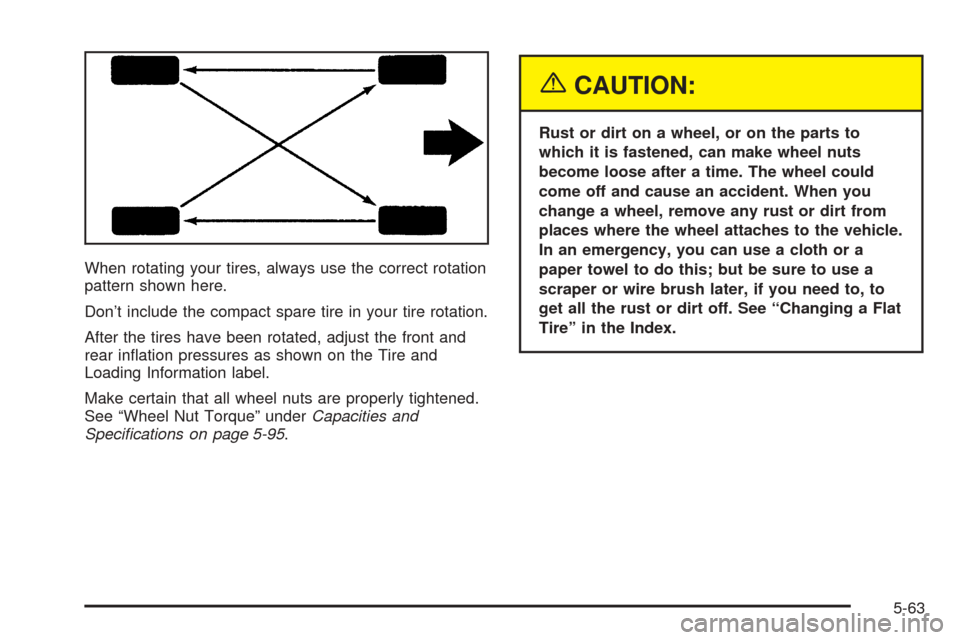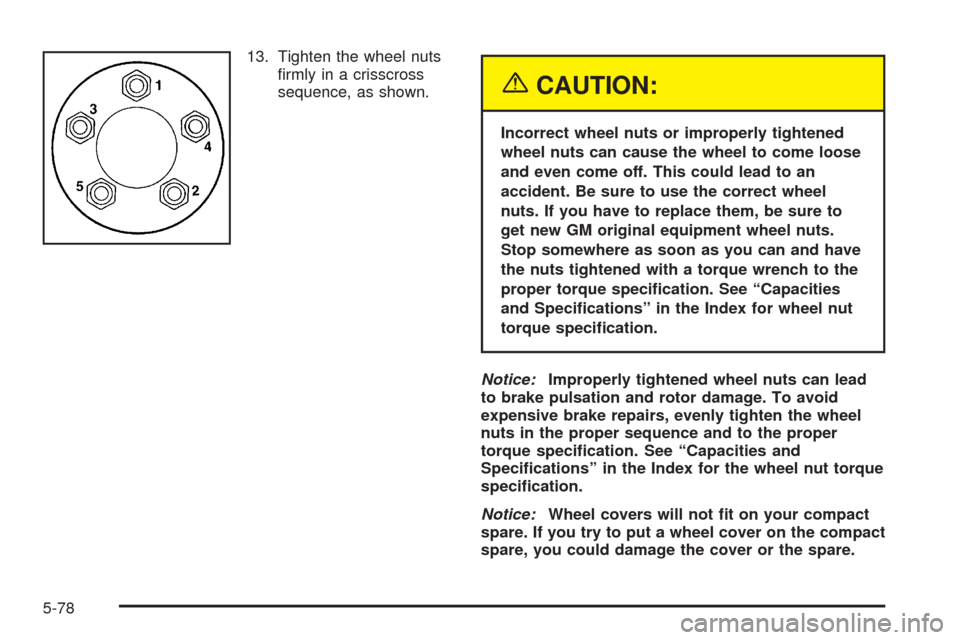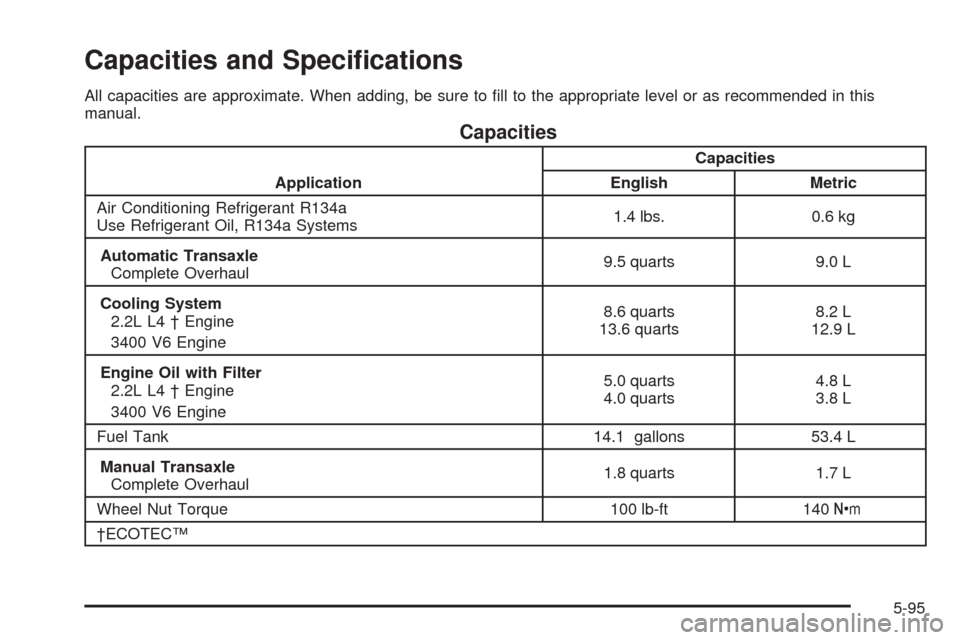wheel torque Oldsmobile Alero 2004 Owner's Manuals
[x] Cancel search | Manufacturer: OLDSMOBILE, Model Year: 2004, Model line: Alero, Model: Oldsmobile Alero 2004Pages: 360, PDF Size: 2.49 MB
Page 260 of 360

Brake Wear
Disc brake pads have built-in wear indicators that make
a high-pitched warning sound when the brake pads
are worn and new pads are needed. The sound
may come and go or be heard all the time your vehicle
is moving (except when you are pushing on the
brake pedal firmly).
{CAUTION:
The brake wear warning sound means that
soon your brakes will not work well. That
could lead to an accident. When you hear the
brake wear warning sound, have your vehicle
serviced.Notice:Continuing to drive with worn-out brake
pads could result in costly brake repair.
Some driving conditions or climates may cause a brake
squeal when the brakes are first applied or lightly
applied. This does not mean something is wrong with
your brakes.
Properly torqued wheel nuts are necessary to help
prevent brake pulsation. When tires are rotated, inspect
brake pads for wear and evenly tighten wheel nuts in
the proper sequence to GM torque specifications.
If you have rear drum brakes, they do not have wear
indicators, but if you ever hear a rear brake rubbing
noise, have the rear brake linings inspected immediately.
Also, the rear brake drums should be removed and
inspected each time the tires are removed for rotation or
changing. When you have the front brake pads
replaced, have the rear brakes inspected, too.
Brake linings should always be replaced as complete
axle sets.
5-40
Page 283 of 360

When rotating your tires, always use the correct rotation
pattern shown here.
Don’t include the compact spare tire in your tire rotation.
After the tires have been rotated, adjust the front and
rear inflation pressures as shown on the Tire and
Loading Information label.
Make certain that all wheel nuts are properly tightened.
See “Wheel Nut Torque” underCapacities and
Specifications on page 5-95.
{CAUTION:
Rust or dirt on a wheel, or on the parts to
which it is fastened, can make wheel nuts
become loose after a time. The wheel could
come off and cause an accident. When you
change a wheel, remove any rust or dirt from
places where the wheel attaches to the vehicle.
In an emergency, you can use a cloth or a
paper towel to do this; but be sure to use a
scraper or wire brush later, if you need to, to
get all the rust or dirt off. See “Changing a Flat
Tire” in the Index.
5-63
Page 298 of 360

13. Tighten the wheel nuts
firmly in a crisscross
sequence, as shown.
{CAUTION:
Incorrect wheel nuts or improperly tightened
wheel nuts can cause the wheel to come loose
and even come off. This could lead to an
accident. Be sure to use the correct wheel
nuts. If you have to replace them, be sure to
get new GM original equipment wheel nuts.
Stop somewhere as soon as you can and have
the nuts tightened with a torque wrench to the
proper torque speci�cation. See “Capacities
and Speci�cations” in the Index for wheel nut
torque speci�cation.
Notice:Improperly tightened wheel nuts can lead
to brake pulsation and rotor damage. To avoid
expensive brake repairs, evenly tighten the wheel
nuts in the proper sequence and to the proper
torque speci�cation. See “Capacities and
Speci�cations” in the Index for the wheel nut torque
speci�cation.
Notice:Wheel covers will not �t on your compact
spare. If you try to put a wheel cover on the compact
spare, you could damage the cover or the spare.
5-78
Page 315 of 360

Capacities and Speci�cations
All capacities are approximate. When adding, be sure to fill to the appropriate level or as recommended in this
manual.
Capacities
ApplicationCapacities
English Metric
Air Conditioning Refrigerant R134a
Use Refrigerant Oil, R134a Systems1.4 lbs. 0.6 kg
Automatic Transaxle
Complete Overhaul9.5 quarts 9.0 L
Cooling System
2.2L L4 † Engine
3400 V6 Engine8.6 quarts
13.6 quarts8.2 L
12.9 L
Engine Oil with Filter
2.2L L4 † Engine
3400 V6 Engine5.0 quarts
4.0 quarts4.8 L
3.8 L
Fuel Tank 14.1 gallons 53.4 L
Manual Transaxle
Complete Overhaul1.8 quarts 1.7 L
Wheel Nut Torque 100 lb-ft 140Y
†ECOTEC™
5-95
Page 358 of 360

Starting Your 3400 V6 Engine...........................2-19
Starting Your Engine.......................................2-18
Steering........................................................4-11
Steering in Emergencies..................................4-12
Steering Tips..................................................4-11
Storage Areas
Center Console Storage Area........................2-35
Cupholder(s)...............................................2-34
Glove Box..................................................2-34
Storing the Flat Tire and Tools..........................5-79
Storing the Spare Tire and Tools.......................5-80
Stuck in Sand, Mud, Ice or Snow......................4-30
Sun Visors.....................................................2-15
Sunroof.........................................................2-35
Supplemental Restraint System (SRS)...............1-54
How Does an Air Bag Restrain?....................1-58
Servicing Your Air Bag-Equipped Vehicle.........1-60
What Makes an Air Bag Inflate?....................1-58
What Will You See After an Air Bag Inflates?......1-58
When Should an Air Bag Inflate?...................1-57
Where Are the Air Bags?..............................1-56
T
Tachometer....................................................3-25
Taillamps
Turn Signal, and Stoplamps..........................5-52
Theft-Deterrent, Radio.....................................3-67
Theft-Deterrent Systems...................................2-16Passlock
®...................................................2-16
Tilt Wheel........................................................ 3-5
Tire Inflation Check........................................... 6-9
Tire Sidewall Labeling......................................5-54
Tire Size.......................................................5-58
Tire Terminology and Definitions........................5-59
Tires.............................................................5-54
Buying New Tires........................................5-65
Chains.......................................................5-69
Changing a Flat Tire....................................5-70
Compact Spare Tire.....................................5-80
If a Tire Goes Flat.......................................5-70
Inflation - Tire Pressure................................5-61
Inspection and Rotation................................5-62
Uniform Tire Quality Grading.........................5-66
Wheel Alignment and Tire Balance.................5-67
Wheel Replacement.....................................5-67
When It Is Time for New Tires......................5-64
To Use the Engine Coolant Heater....................2-21
Top Strap......................................................1-41
Top Strap Anchor Location...............................1-43
Torque Lock...................................................2-29
Total Weight of Your Vehicle’s Tires...................4-42
Towing
Recreational Vehicle.....................................4-31
Towing a Trailer..........................................4-39
Your Vehicle...............................................4-31
Traction
Enhanced Traction System (ETS).................... 4-9
Enhanced Traction System (ETS) Active Light....3-31
12